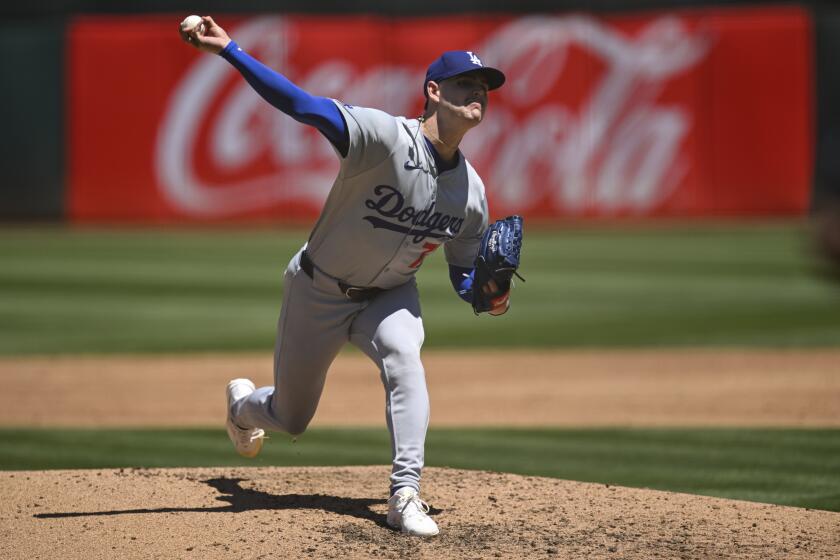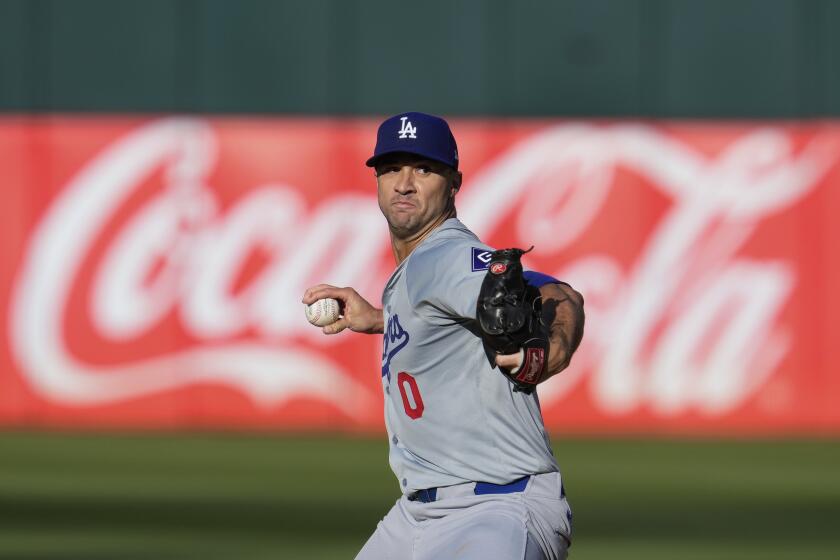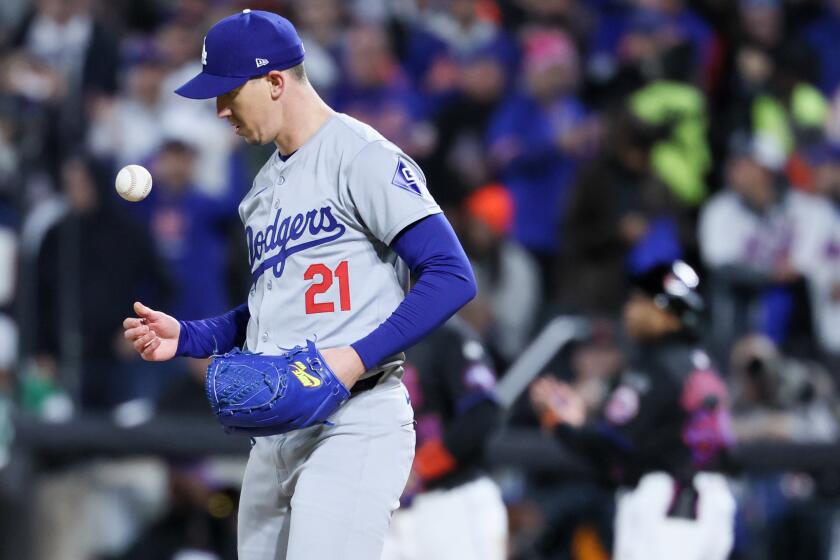Dodgers face ‘sense of urgency and competition’ with roster for the rest of the season

The “calvary,” as Dodgers manager Dave Roberts put it this weekend, is coming.
Which means not everyone in the team’s current stable is likely to keep their spot.
In recent weeks, much of the external attention on the Dodgers has revolved around their shrinking cushion in the National League West standings, where a lead once as large as nine games has been trimmed down to 4½ by the San Diego Padres (and five by the Arizona Diamondbacks) entering Monday’s games.
Inside the clubhouse, however, urgency is emanating from a different source — with a wave of trade deadline arrivals and soon-to-return members of the injured list creating pressure through a roster math problem.
The Dodgers are, essentially, facing a sort of baseball Darwinism the rest of the season — with a bloated roster likely to be trimmed down the stretch, and a number of players uncertain to make the final cut.
Dodgers win rubber game of series as bullpen comes through to make a one-run lead hold up in win over A’s.
“There should be a sense of urgency and competition,” Roberts said Sunday, adding: “We’ve got more guys coming than we have spots.”
Most position groups figure to apply.
For example, the Dodgers have three left-handed-hitting outfielders — Jason Heyward, James Outman and the newly acquired Kevin Kiermaier — on a team that, at full strength, will only need two at most (and maybe just one if Mookie Betts or Tommy Edman see significant outfield time once they return from the injured list).
The club has six utility players — Edman, Kiké Hernández, Amed Rosario and Cavan Biggio on the active roster; Chris Taylor and Miguel Rojas on the injured list — for maybe only three or four ultimate spots.
Same story in the bullpen, where the Dodgers currently have eight arms that have all pitched leverage innings this year, but also three rehabbing relievers nearing returns (Brusdar Graterol and Michael Grove could be back as soon as this week’s homestand; Ryan Brasier isn’t far behind them), plus an unsettled closer’s role.
Even the rotation remains an ever-changing battle; both for depth spots among rookie pitchers (River Ryan, Landon Knack and Justin Wrobleski have all cycled through this year), and coveted potential postseason starts (especially if Yoshinobu Yamamoto returns from his shoulder injury in September, as Roberts said this weekend he expects).
“It should be a meritocracy,” Roberts said. “At some point, the rubber meets the road, and we’ve got to make some tough decisions.”
For some players, improvement might come naturally.
A month ago, Gavin Lux looked destined for a diminished late-season role. Some rival executives wondered if he could wind up on the trade block.
Instead, Lux has turned into one of the team’s best hitters over the last four weeks, batting .386 in his last 19 games (with nine extra-base hits and 15 RBIs) while bumping up to the No. 3 spot in a shorthanded batting order.
“I think you feel that pressure a little bit, but I wasn’t going out there thinking about it every day,” Lux said, pushing back on the idea his play improved as a result of roster pressure.
Others might benefit from more internal competition.
When discussing this dynamic Sunday, Roberts pointed specifically to Hernández, who might finally be turning a corner after a dismal first-half performance.
“He’s playing his best baseball that he’s played in a while, on both sides of the ball,” Roberts said of Hernández, who is batting .300 since the All-Star break with five doubles and eight RBIs. “No. 1, he’s playing good baseball. But I also feel that he’s smart enough to realize that there’s other guys that are coming. And how do you keep getting opportunities? You perform.”
Following his two-double performance Sunday, Hernández insisted he wasn’t overly worried about his place on the roster.
“It is what it is,” he said. “I’m not really thinking about that. That’s out of my control.”
At the same time, however, Hernández acknowledged the pressure he feels to perform — both as it relates to his personal goals, and also the overall outlook of the club.
“This game is about producing, or you’re gonna be out of the game,” he said. “Just trying to do my part. We’ve been struggling as a team, and I believe that if I’m anywhere close to the hitter that I’m capable of being, we’d be in better shape and a better spot.”
Indeed, this might be the best path forward for the Dodgers to rectify their top-heavy roster problems.
Instead of adding another everyday bat to the lineup at the trade deadline — the team didn’t meet asking prices for potential targets, including Randy Arozarena of the Tampa Bay Rays and Luis Robert Jr. of the Chicago White Sox — the club loaded up on depth and versatility.
As a result, they now have 18 position players on their 40-man roster with extensive MLB experience, for only 13 available roster spots once they reach the playoffs.
The Dodgers’ trade deadline deal is immediately paying off, with Jack Flaherty performing well during a win over the Oakland Athletics on Saturday.
Those additions were necessary in the short term, putting Band-Aids on many of the Dodgers’ injury-induced shortcomings.
“It’s trying to weather or withstand a regular season,” Roberts said. “So you have to kind of backfill.”
But once everyone gets back, there will be important personnel choices for the Dodgers to make leading up to October.
Their hope is that, between now and then, the cream of their depth chart will rise to the top.
“That’s the way it should be,” Roberts said. “That’s a good thing for the organization.”
More to Read
Are you a true-blue fan?
Get our Dodgers Dugout newsletter for insights, news and much more.
You may occasionally receive promotional content from the Los Angeles Times.











